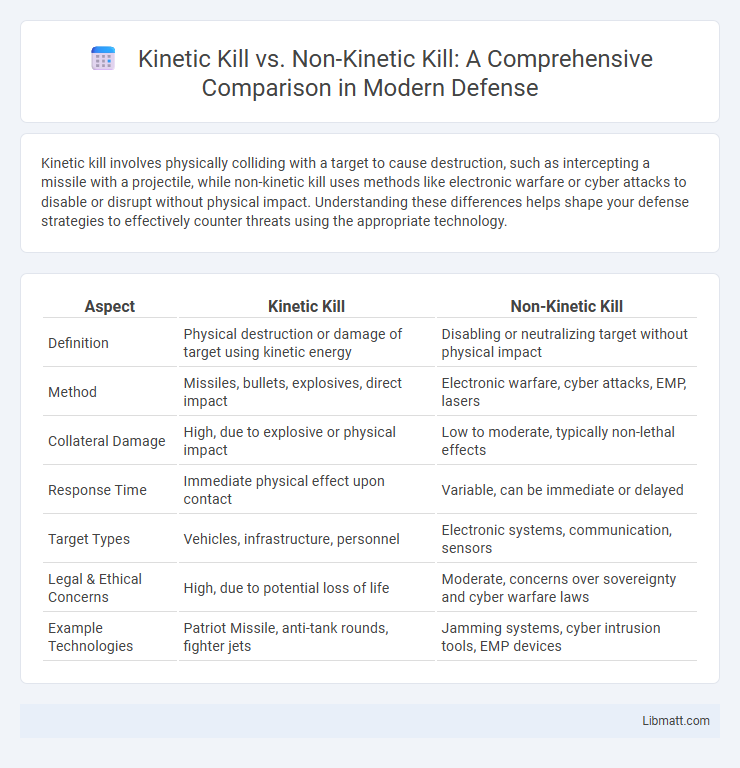Kinetic kill involves physically colliding with a target to cause destruction, such as intercepting a missile with a projectile, while non-kinetic kill uses methods like electronic warfare or cyber attacks to disable or disrupt without physical impact. Understanding these differences helps shape your defense strategies to effectively counter threats using the appropriate technology.
Table of Comparison
| Aspect | Kinetic Kill | Non-Kinetic Kill |
|---|---|---|
| Definition | Physical destruction or damage of target using kinetic energy | Disabling or neutralizing target without physical impact |
| Method | Missiles, bullets, explosives, direct impact | Electronic warfare, cyber attacks, EMP, lasers |
| Collateral Damage | High, due to explosive or physical impact | Low to moderate, typically non-lethal effects |
| Response Time | Immediate physical effect upon contact | Variable, can be immediate or delayed |
| Target Types | Vehicles, infrastructure, personnel | Electronic systems, communication, sensors |
| Legal & Ethical Concerns | High, due to potential loss of life | Moderate, concerns over sovereignty and cyber warfare laws |
| Example Technologies | Patriot Missile, anti-tank rounds, fighter jets | Jamming systems, cyber intrusion tools, EMP devices |
Introduction to Kinetic and Non-Kinetic Kill Methods
Kinetic kill methods rely on physical impact or explosive force to neutralize targets, commonly used in missiles, projectiles, and ballistic weaponry for direct destruction. Non-kinetic kill methods employ electronic warfare, cyber attacks, or directed energy weapons to disable or disrupt enemy systems without physical damage. These approaches offer strategic advantages in modern combat by enabling both precise conventional strikes and covert operational capabilities.
Defining Kinetic Kill: Mechanisms and Applications
Kinetic kill refers to the process of neutralizing a target through direct physical impact, using objects or projectiles such as missiles, bullets, or debris to destroy or incapacitate. This mechanism relies on the transfer of kinetic energy to cause structural damage, commonly employed in missile defense systems and ballistic weaponry. Understanding how kinetic kill works enables you to assess its effectiveness in intercepting threats versus non-kinetic alternatives like electronic warfare or cyber attacks.
Understanding Non-Kinetic Kill: Techniques and Use Cases
Non-kinetic kill involves disabling or neutralizing a target without physical impact, utilizing techniques such as electronic warfare, cyber-attacks, and electromagnetic pulses. These methods disrupt enemy systems, communication networks, and sensors, rendering them ineffective while minimizing collateral damage. Your strategic approach benefits from integrating non-kinetic capabilities to achieve mission objectives in environments where kinetic actions are impractical or undesirable.
Historical Evolution of Kinetic and Non-Kinetic Warfare
Kinetic kill methods, rooted in traditional warfare, evolved from early projectile weapons to modern missiles and firearms, emphasizing physical destruction through impact or explosion. Non-kinetic warfare emerged with advancements in electronic and cyber technologies, focusing on disruption, deception, and disablement without direct physical damage, such as electronic warfare and cyber attacks. Your understanding of conflict dynamics now requires integrating both kinetic and non-kinetic strategies, reflecting the historical shift towards multidimensional battlefields.
Operational Scenarios: When to Use Kinetic vs Non-Kinetic Kill
Kinetic kill methods are optimal in scenarios requiring direct physical destruction of targets, such as missile intercepts and anti-armor operations, where immediate neutralization is critical. Non-kinetic kill techniques excel in electronic warfare, cyber operations, and psychological tactics, effectively disrupting enemy systems and command without physical damage. Selecting between kinetic and non-kinetic options depends on mission objectives, desired effects, collateral damage considerations, and operational environment constraints.
Technological Advances in Kinetic Kill Systems
Technological advances in kinetic kill systems have significantly enhanced the precision and effectiveness of missile defense and anti-satellite weapons by utilizing high-speed impact to neutralize targets without explosive warheads. Developments in guidance algorithms, propulsion systems, and sensor integration have enabled real-time target tracking and interception at greater distances and speeds. These improvements reduce collateral damage and increase mission success rates compared to traditional explosive-based methods.
Innovations in Non-Kinetic Weaponry
Innovations in non-kinetic weaponry have transformed modern defense strategies by enabling the neutralization of threats without physical destruction. Technologies such as electromagnetic pulses, directed energy weapons, and cyber-attacks disrupt enemy communications, electronics, and infrastructure with precision and minimal collateral damage. Your enhanced understanding of these advancements underscores the strategic shift from traditional kinetic kill methods to more controlled and reversible means of engagement.
Comparative Effectiveness: Kinetic Kill vs Non-Kinetic Kill
Kinetic kill systems rely on physical impact to destroy targets, offering immediate and tangible damage that is highly effective against armored or hardened threats. Non-kinetic kill methods, such as electronic warfare or cyber attacks, disable or disrupt enemy systems without physical destruction, enabling stealthy and reversible effects with minimal collateral damage. Comparative effectiveness depends on mission goals; kinetic kills excel in outright destruction, while non-kinetic kills provide strategic advantages by neutralizing capabilities without physical loss.
Ethical and Legal Considerations in Modern Warfare
Kinetic kill methods involve physical destruction and directly engage targets, raising complex ethical questions about collateral damage and proportionality under international humanitarian law. Non-kinetic kill techniques, such as cyber attacks or electronic warfare, challenge existing legal frameworks by causing indirect harm without physical destruction, often complicating attribution and accountability. Understanding these nuances is crucial for ensuring Your military strategies comply with evolving ethical standards and legal obligations in modern warfare.
Future Outlook: Integration of Kinetic and Non-Kinetic Capabilities
The future outlook for kinetic kill and non-kinetic kill technologies emphasizes seamless integration to enhance multi-domain operations and improve mission success rates. Advances in artificial intelligence, directed energy weapons, and cyber capabilities are driving convergence, enabling You to deploy hybrid solutions that maximize efficiency and minimize collateral damage. This integrated approach will redefine warfare strategies, combining physical destruction with electronic disruption for superior battlefield dominance.
Kinetic kill vs Non-kinetic kill Infographic

 libmatt.com
libmatt.com